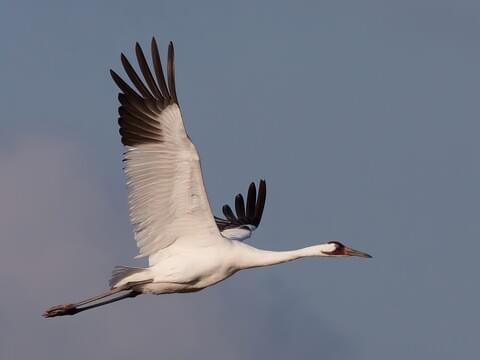
An endangered bird, 8 whooping cranes have left their shells and joined the world.
The experimental effort to revive Louisiana’s endangered whooping crane population had a veritable baby boom this year. Fifteen chicks hatched during the recent breeding season and eight survived to the fledgling stage. Eight surviving chicks is a record for the state Department of Wildlife and Fisheries’ whooping crane reintroduction project, which began in 2011. The young ‘whoopers’ bring the species’ Louisiana population to 76. Whooping cranes are the most endangered of the world’s crane species, according to Wildlife and Fisheries. Once numbering more than 10,000 in North America, the five-foot-tall birds’ numbers fell to just 20 in the 1940s due to hunting and habitat loss. There are now about 1,000 worldwide.
nola.com
The first hatching was in 2016 and so far over 150 birds have come to Louisiana with births and donations.
The project’s first wild-hatched chick, born in 2016, was also the first whooping crane birth in Louisiana in more than 75 years. Since the project began, Wildlife and Fisheries and other groups have released more than 150 whooping cranes that were hatched in captivity or brought to Louisiana from other states. Why so many crane babies this year? “We can’t point out exactly why this was our best year,” Wildlife and Fisheries biologist Sara Zimorski said. “It could be partly the age and experience of the birds. We certainly have birds that have gained experience hatching and raising chicks over the previous few years, but we did also have some new pairs who were successful for the first time this year.” Dry conditions during the breeding season, which runs from February to June, may have also helped. “I don’t think we’ve had a nesting season during a drought like we had this year,’’ Zimorski said, noting that other bird species have productive breeding seasons during dry years that follow wet years.
The cranes are slow to mature and only lay 1-2 eggs in a normal breeding cycle.
Whooping cranes are slow to mature, reaching reproductive age after four or five years, and lay one or two eggs during a nesting attempt. Despite their protected status, whooping cranes are sometimes targeted by gun owners. At least 12 of the birds have been shot in Louisiana, giving the state the highest confirmed shooting rate of whooping cranes of any state or Canadian province, according to the International Crane Foundation. Texas comes in second with eight whooping crane gunshot deaths. In 2016, a Rayne man and a juvenile shot two cranes in Acadia Parish. The man was ordered to pay $85,000 and had to complete 360 hours of public service. A Ville Platte man was sentenced to two years of probation and 120 hours of public service for shooting a whooping crane near Bunkie in 2018. A year later, another crane was gunned down in Jefferson Davis Parish, prompting a $10,000 reward for information about the shooting. Wildlife and Fisheries advises anyone encountering a whooping crane to keep their distance and to report the sighting at: www.wlf.louisiana.gov/page/report-a-whooping-crane-sighting-or-violation
I have only seen them in the zoo and do not understand why someone would shoot one.
